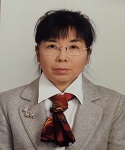| Biography | |
|---|---|
 Prof. Noriko Akutsu Osaka Electro-Communication University, Japan |
|
| Title: Faceted macrosteps in the step droplet zone in non‐equilibrium steady states | |
| Abstract: Faceted macrosteps are known to degrade grown crystals. SiC, for example, is being considered for use infuture power devices. However, faceted macrosteps keep grown crystal from reaching sufficient crystal qualityfor preparing devices.
To study the dynamics of faceted macrosteps, we proposed a lattice model which keeps faceted macrostep at equilibrium. The lattice model is a restricted solid-on-solid model with a point-contact-type step-step attraction (p-RSOS model) [1-4]. Here, “restricted” means that the height difference between nearest neighbor site is restricted to {-1, 0, 1}. The origin of the point-contact-type step-step attraction is considered to be the orbital overlap of the dangling bonds at the meeting point of the neighboring steps. The energy gained by forming the bonding state εint (<0) is regarded as the attractive energy between steps.
We calculated surface tension of the vicinal surface [1-4] on the p-RSOS model and drew the polar graph of the surface tension (Wulff figure) [3,4]. To obtain reliable results in one dimension, we used the density matrix renormalization group (DMRG) method. The calculated surface tension was discontinuous at low temperatures.
Corresponding to the connectivity of the surface tension calculated by the DMRG method, we obtained the faceting diagram [3].For the strength of step-step attraction, there are two transition temperatures. One is Tf,1. For the temperatures T<Tf,1, the surface tension of the (111) surface becomes discontinuous. The other is Tf,2. For T<Tf,2<Tf,1, the surface tension of the (001) surface becomes discontinuous. The area Tf,2<T< Tf,1, is the step-droplet zone. Thanks to the anomaly of the surface tension at the (111) surface, the faceted macrosteps whose side surface is the (111) exist stably at equilibrium.
Then, by using the Monte Carlo method, we calculated the driving force ∆μdependence of the height of the faceted macrostep in the non-equilibrium steady state. Without other kinetic effects such as surface diffusion, volume diffusion, elastic effects, etc., the height of the faceted macrostep decreases as the absolute value of ∆μ increases. For ∆μR<|∆μ |, the vicinal surface crossover to a rough surface kinetically.
[1] N. Akutsu, “Non-universal equilibrium crystal shape results from sticky steps”, J. Phys. Condens. Matter, 23, 485004 (2011); “Sticky steps inhibit step motions near equilibrium”, Phys. Rev. E 86, 061604 (2012).
[2] N. Akutsu, “Faceting diagram for sticky steps”, AIP Advances, 6, 035301 (2016).
[3] N. Akutsu, (Invited) “Profile of a Faceted Macrostep Caused by Anomalous Surface Tension”, Adv. Condens. Matter Phys., 2017, Article ID 2021510, doi:10.1155/2017/2021510.
[4]N. Akutsu,"Disassembly of Faceted Macrosteps in the Step Droplet Zone in Non-Equilibrium Steady State", Crystals, 7, Article ID cryst7020042, doi:10.3390/cryst7020042.
Keywords
Surface tension,Faceting diagram, Faceted macrosteps, Equilibrium crystal shape, Wulff figure, Kinetic roughening, Self-assembling, Self-organized
| |
| Biography:
Noriko Akutsu is the Head of the Division of Electronics and Applied Physics at the Graduate School of Engineering of the Osaka Electro-Communication University (OECU, Japan). She is a Professor at the Department of Environmental Science of the OECU. She holds a Master degree in Physics from the Ochanomizu University (Japan), and holds a Doctor of Science in Physics from the Gakushuin University (Japan). She earned the Best Paper Award from the Japanese Association of Crystal Growth with co-workers in 1993.She has published more than 50 papers in journals such as Physical Review Letters, Physical Review B, Physical Review E, AIP Advances, Journal of Physics: Condensed Matters, Journal of Physics A (UK), Crystals, Surface Science, Applied Surface Science, Journal of Crystal Growth, Advances in Condensed Matter Physics, Surface and Interface Analysis, e-Journal of Surface Science and Nanotechnology, Progress of Theoretical Physics, andthe Journal of Physical Society of Japan. She has also published one section in the Hand Book of Crystal Growth from Elsevier. She is appointed in Academic society as Cooperation-Member of the ScienceCouncil of Japan, a Representative of the Physical Society of Japan, and a Member of Executive Committee of the Japanese Association of Crystal Growth. Previously, she was appointed as a member of Sub-committee 2, Scientific Research (S), and Committee on Grants-Aid for Scientific Research in Japan Society for the Promotion of Science. Currently, she is interested in the calculations of the surface tension of crystals, the step dynamics of faceted macrosteps, and two-dimensional heterogeneous nucleation at the facet edge on the macrostep.
| |
